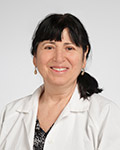Overview
According to the American Massage Therapy Association (AMTA), massage therapy promotes health and well-being by way of soft tissue manipulation and movement of the body. At Cleveland Clinic, our massage therapists use massage techniques to treat disorders of the human body, promote healing, improve clinical outcomes and encourage higher levels of wellness.
Our professionally trained and licensed massage therapists use touch to manipulate the tissues of the body in a skilled, sensitive and compassionate way.
Many patients enjoy massage therapy as a regular part of maintaining wellness, while others may use it as a temporary treatment for specific injuries or conditions.
What We Treat
Massage therapists use a variety of manual therapy techniques to help manage and relieve many different physical conditions and injuries. Some methods target issues related to stress or emotional health, while others focus on injuries from car accidents, postsurgical recovery or chronic pain.
Some therapeutic techniques may help relieve symptoms across multiple body systems:
- Respiratory conditions (such as sinus pressure) may improve with trigger point release or MLD (manual lymphatic drainage).
- Congestive chest conditions may benefit from tapotement (a short, rapid rhythmic tapping technique) or cupping therapy.
- Neurological and muscular disorders — such as headaches, migraines, neck pain, tennis elbow, low back pain, frozen shoulder and pain related to osteoarthritis, tendonitis or menstruation — can be managed with a range of therapeutic massage techniques.
- Postoperative pain and swelling may lessen with MLD and therapeutic massage.
Massage therapy offers many benefits, but it may not be right for you if you have certain current or past medical conditions. Please talk with your provider before treatment if you:
- Take blood thinners (anticoagulants), which may cause bruising
- Have blood clots in your leg
- Have tumors
- Have a high-risk pregnancy
- Have osteoporosis or a spine disorder, which can put you at risk for fractures
- Use a medical device implanted or attached to your body
- Have an acute injury or have had surgery within the last 48 hours
What To Expect
A massage therapy session usually lasts about 50 minutes. The lighting in the room is low and subtle to help create a sense of relaxation before the massage even begins. Gentle, soothing music plays in the background throughout the massage.
More than 80 types of massage therapy exist. With such a vast variety of techniques and possible combinations, the way you’ll feel during treatment can be hard to predict. Some techniques use less pressure than the weight of a hand, while others press intensely into certain points to release muscle tension. Before treatment, discuss with your therapist which technique or techniques will be used and what they should feel like. During the course of treatment, it’s ok to talk to your therapist about what you feel and your comfort level. Some patients describe sensations that are painful in a good way, but if you experience any pain that causes you discomfort, please tell your therapist right away.
Benefits of massage therapy
Most patients feel more relaxed, especially if they have massage therapy sessions regularly. Research shows that massage therapy can help reduce pain, decrease autoimmune illnesses, depression, anxiety, and enhance immune function. Specifically, massage therapy can:
- Increase range of motion and flexibility
- Increase blood and lymph function
- Help people respond to and better tolerate medical procedures and other related therapies
- Reduce pain, depression, stress and anxiety related to illness
- Reduce muscle tension or soreness, and help restore muscle tone lost through long-term bed rest, stress and anxiety
Our Team
 Victoria "Vickie" Bodner, LMT |
 Tori Harsha, LMT |
 DeBorah Hill, LMT |
 Lyanette Jobson, LMT |
 Sarah Jones, LMT |
 Claire Macoscko, LMT |
 Ryan Wiebusch, LMT |
 Yelena Yefremenko, LMT |
Appointments & Locations
To schedule an appointment with one of our massage therapists, please call 216.448.4325. Appointments can also be scheduled online via MyChart.
Locations
Current locations offering massage therapy appointments:
Reiki
What is reiki?
Reiki is hands-on natural healing using the universal life force energy. The term comes from the Japanese words “rei,” meaning universal, and “ki,” which means vital life force energy that flows through all living things. Reiki, an abundant, gentle spiritual energy is not tied to any specific religion or nationality.
What are the benefits of receiving reiki treatment?
According to the National Center for Complementary and Alternative Medicine, people use reiki for relaxation, stress reduction and symptom relief, in efforts to improve overall health and well-being. A reiki treatment may do the following:
- Bring about a peaceful, deep state of relaxation
- Dissolve energy blockages and tension
- Detoxify the body
- Support the well-being of a person receiving traditional medical treatment that is debilitating (e.g., chemotherapy, radiation, surgery, kidney dialysis)
- Supply universal life force energy to the body
- Stimulate the body’s immune system
- Help to relieve pain
- Stimulate tissue and bone healing after injury or surgery
- Increase the vibrational frequency on physical, mental emotional and spiritual levels
Reiki, which is used all over the world including in many hospitals and hospices, aids in healing by helping people become more balanced physically, emotionally, mentally and spiritually.
What we treat
What conditions can be treated by reiki?
Reiki is not specific to any particular type of disease or condition. Because it works on the entire self, mind, body and emotions - it may be successful in all types of physical, emotional, mental and spiritual healing.
Reiki practitioners in our Center for Integrative and Lifestyle Medicine help patients to prepare for surgery, which may help boost recovery afterward.
Our reiki practitioners see patients for the following conditions, among others:
- Chronic pain
- Digestive problems
- Parkinson’s disease
- Stress-related diseases
- Psychological illnesses
Will I benefit from reiki if I am in good health?
Yes. If you are in good health already, regularly applied reiki treatments (about once a month) enhance your ability to respond to unhealthy elements in your environment and help you to handle stress. By promoting the harmonious distribution of energy, reiki is an excellent form of preventive medicine.
Can reiki replace traditional medical or therapeutic treatments?
No. Reiki complements all other types of medical and therapeutic treatments. Reiki treatment should not be used as a substitute for consultation or a physician, a practitioner or natural therapeutics or a psychotherapist. Reiki can increase the efficacy of other types of healing.
What to expect
How does reiki work?
The reiki practitioner is the conduit between the patient and the source of the universal life force energy; the energy flows through the practitioner’s energy field and through their hands to the patient. (The energy does not come from the practitioner; rather it comes through the practitioner from the universal source. There is no energy drain on the practitioner).
Reiki treatments typically last about 50 minutes. During the treatment, the patient lies on a massage table, fully clothed. The reiki practitioner gently places their hands palm down on or hovers just above the patient’s body in a specific energy location and uses a series of 12 to 15 different hand positions. The length of time that the practitioner leaves their hands in each position is determined by the flow of energy through their hands at each location. There is no pressure, massage or manipulation involved.
The patient may experience the energy as sensations such as heat, tingling or pulsing where the practitioner has placed their hands. Sometimes, the sensations are felt moving through the body; some people do not perceive any sensations at all. Most people feel very relaxed and peaceful, and many fall asleep during the treatment.
Lymphatic Drainage Massage
If you’re experiencing uncomfortable swelling from lymphedema — especially after cancer treatment or breast cancer surgery — lymphatic drainage massage can help you feel more at ease in your body. This gentle, targeted technique supports your lymphatic system by encouraging fluid to move away from swollen areas, easing inflammation and restoring a natural sense of balance.
Could you benefit from lymphatic drainage massage?
When your lymphatic system isn’t working well, fluid and toxins can build up in your body. And that can lead to a wide range of symptoms that might not seem obviously connected. You might feel bloated, foggy or unusually tired. You could experience frequent sinus infections, stubborn headaches or swelling in your hands and ankles.
Maybe your skin feels dry, breaks out easily or seems more sensitive than usual. You might even notice swollen lymph nodes in your neck. These can all be signs that your lymphatic system is flowing as it should.
If any of this sounds familiar, lymphatic drainage massage may give your body the boost it needs to feel lighter, clearer and more energized.
Conditions we treat with lymphatic drainage massage
Lymphatic drainage isn’t just a gentle massage. It’s a powerful tool for restoring comfort and reducing swelling after surgery and to manage lymphedema related to a variety of health conditions, including:
- Chronic congestion
- Fibromyalgia
- Headaches
- Lipedema
- Musculoskeletal pain
- Neuropathy
- Rheumatoid arthritis
- Stress
Facial lymphatic massage can also help reduce puffiness, boost circulation and leave your skin looking refreshed and radiant.
Lymphatic drainage massage can be a great addition to your care if you’re experiencing lymphedema, whether it’s the result of a health condition, surgery or cancer treatment. A lot of people find it helps reduce swelling and makes them feel more comfortable. But it’s not the right fit for everyone. If you’re thinking about trying it, talk to your healthcare provider first. They can let you know if it’s a safe choice for you and help you weigh the potential benefits.
Prenatal Massage Therapy
What is a prenatal massage — and how is it different from other massages?
Having a massage during pregnancy looks and feels different from having a massage at other times. A prenatal massage is generally going to be very light pressure — no more than a firm to medium pressure especially around the low back and hips. It’ll be more like a Swedish massage with very light stroking techniques, like kneading. To make sure you’re comfortable and your body is aligned properly, massage therapists offer prenatal massage pillows, padded bolsters and other massage props.
Prenatal massage benefits
When you’re pregnant, taking time out for self-care is vital. Later in pregnancy, a massage can not only be soothing, but also offer multiple health benefits, such as
- Alleviating pain
- Decrease swelling
- Relieving insomnia
- Reducing stress and anxiety
- Reducing labor pain
These benefits can also be long-lasting. In fact, increased oxytocin production due to prenatal massage can also help improve labor outcomes. Oxytocin is known to help improve labor contractions.
Massage techniques utilized during prenatal massage
There are many different prenatal massage techniques that therapists tend to use. Some may include:
- Swedish massage techniques
- Myofascial release therapy
- Craniosacral therapy
- Manual lymphatic drainage
They all can be very effective with pain relief and overall discomfort. These techniques are very gentle and slow movements to promote blood flow, lymphatic flow and relaxation. Your massage therapist should avoid putting deep pressure on your abdomen, lower back and legs. Certain areas contain pressure points that may induce labor, more specifically, they should avoid the areas around your ankles and a few of your toes.
Potential risks of prenatal massage
If you are considering a prenatal massage, make sure to always consult your OBGYN before receiving massages during pregnancy, especially if you are considered a high-risk pregnancy. Symptoms and diagnosis that may consider you high-risk include:
- Blood clots
- Bleeding disorders
- High blood pressure
- Diabetes
- Preeclampsia
- Abdominal pain
- Pitting edema
- Heart disease
- Unexplained symptoms
- Previous pre-term labor or miscarriage
What to wear
Luckily, you don’t need to wear anything special for a prenatal massage. Whatever makes you feel most comfortable is the right thing to wear.
During a massage, you’re covered by sheets and a blanket, so most people dress all the way down. Others prefer to wear pregnancy drapes because they are more movable. Some people prefer to stay in their undergarments. It all depends on your comfort level.
Therapeutic Massage
What can I expect from a therapeutic massage?
During your visit, expect low lighting and soft music, as with a relaxation massage. A therapeutic massage session may consist of a whole-body treatment or may just focus on your targeted area of concern for an extended period of time.
There’s no standard or typical therapeutic massage routine. Your massage therapist will tailor your massage to your unique and specific health needs. Therapeutic massages focus on your body’s soft tissue (your muscles, fascia, tendons and ligaments). It’s done by licensed professionals specifically trained to identify and focus on problem areas.
The massage work in a therapeutic massage may feel deeper than a relaxation massage. You may also experience more tenderness as your massage therapist works through the tissue that needs released, often described as the “hurts so good” sensation. Communication is key during a therapeutic massage. It’s always important to let your massage therapist know if the pressure feels too deep or uncomfortable.
Soft tissue manipulation like deep-tissue massage and Swedish massage are commonly used techniques. Depending on your massage therapist’s training and your specific needs, they may incorporate other techniques into your treatment, such as:
- Craniosacral release
- Lymphatic drainage massage
- Myofascial release
- Trigger point work
- Passive-resistive stretching
- Cupping therapy
- Instrument assisted soft tissue mobilization
Therapeutic massage benefits
Benefits of massage can go far beyond relaxation. Focused therapeutic massage techniques may:
- Decrease pain and increase your range of motion, make it easier to move and function more normally, and help you heal faster from a variety of medical concerns.
- Increases both blood flow and lymphatic drainage
- Help reduce swelling and inflammation
- Break up scar tissue
You can also make massage therapy a regular part of your wellness maintenance routine, like to relieve stress on an ongoing basis or to help keep chronic pain at bay.
Am I a good candidate for therapeutic massage?
Therapeutic massage, often known as medical massage, uses many different techniques to address a variety of diseases, injuries and types of pain. Therapeutic massage techniques can work on issues that are either chronic (meaning they last a long time) or acute (an issue that happened recently and can be cared for in the near future).
Some examples are:
- Back pain
- Frozen shoulder
- Headaches, including migraines, cluster headaches, tension headaches or sinus headaches
- Whiplash
- Muscle strains and repetitive strain injuries from sitting or standing postures that are held for several hours a day (including working a sedentary desk job)
- Temporomandibular joint disorder (TMJ)
- Tendonitis
Medical massage may also help relieve some of the pain and discomfort associated with cancer treatment and post-operative recovery. Any existing health issues you have should be discussed with your doctor prior to treatment. Then, if you do pursue medical massage, your therapist will need to know about them up front.
Some people with preexisting medical conditions may not benefit from massage therapy. Speak to your healthcare provider beforehand if you have:
- A condition that requires you to take blood-thinning medication, as this could contribute to bruising
- Any kind of medical devices implanted in or attached to your body
- Blood clots in your legs (deep vein thrombosis)
- Osteoporosis, which could make you vulnerable to fractures
- Tumors
